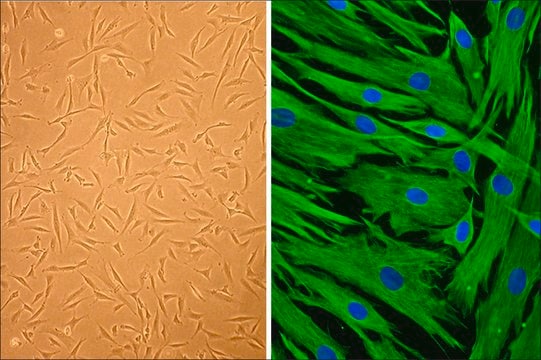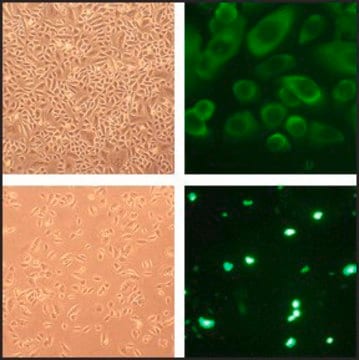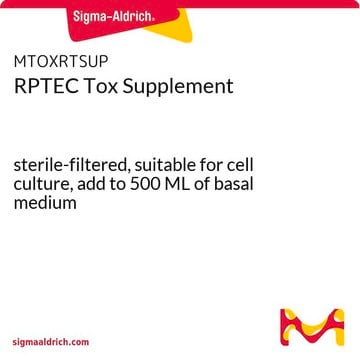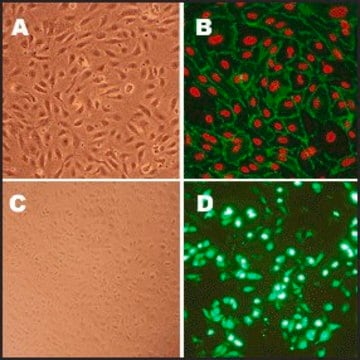930-05A
Human Renal Proximal Tubular Epithelial Cells: HRPTEpC, adult
Synonym(s):
Proximal Tubular Epithelial Cells
Sign Into View Organizational & Contract Pricing
All Photos(1)
About This Item
UNSPSC Code:
41106514
NACRES:
NA.81
Recommended Products
biological source
human kidney
Quality Level
packaging
pkg of 500,000 cells
manufacturer/tradename
Cell Applications, Inc
growth mode
Adherent
technique(s)
cell culture | mammalian: suitable
shipped in
dry ice
storage temp.
−196°C
General description
Lot specific orders are not able to be placed through the web. Contact your local sales rep for more details.
Human Renal Proximal Tubular Epithelial Cells (HRPTEpC) provide a useful tool for studying various aspects of pathology and biology of the human renal proximal tubular cells in vitro. HRPTEpC have recently been used in a study of metabolic enzymes responding to energy depletion in renal cells. HRPTEpCs have a pivotal role in kidney function including reabsorbtion of glucose and protein, and also play a part in the glucotoxicity associated with diabetes.
Human Renal Proximal Tubular Epithelial Cells (HRPTEpC) provide a useful tool for studying various aspects of pathology and biology of the human renal proximal tubular cells in vitro. HRPTEpC have recently been used in a study of metabolic enzymes responding to energy depletion in renal cells. HRPTEpCs have a pivotal role in kidney function including reabsorbtion of glucose and protein, and also play a part in the glucotoxicity associated with diabetes.
Cell Line Origin
Kidney
Application
Kidney disease, diabetes, glucotoxicity, pathology. kidney function, reabsorbtion of glucose and protein, biology of renal proximal tubular cells in vitro, metabolic enzymes, cell energy usage.
Packaging
First or second passage, >500,000 cells in RenaEpi Basal Medium containing 10% FBS & 10% DMSO.
Components
RenaEpi Basal Medium containing 10% FBS & 10% DMSO
Quality
Each lot was tested for proper morphology, ability to attach and spread on tissue culture ware surface, and proliferate in RenaEpi Growth Medium, Negative for HIV, Hepatitis B, Hepatitis C, mycoplasma, bacteria, and fungi.
Other Notes
Can be cultured at least 6 population doublings
Disclaimer
RESEARCH USE ONLY. This product is regulated in France when intended to be used for scientific purposes, including for import and export activities (Article L 1211-1 paragraph 2 of the Public Health Code). The purchaser (i.e. enduser) is required to obtain an import authorization from the France Ministry of Research referred in the Article L1245-5-1 II. of Public Health Code. By ordering this product, you are confirming that you have obtained the proper import authorization.
Storage Class Code
10 - Combustible liquids
WGK
WGK 3
Flash Point(F)
Not applicable
Flash Point(C)
Not applicable
Certificates of Analysis (COA)
Search for Certificates of Analysis (COA) by entering the products Lot/Batch Number. Lot and Batch Numbers can be found on a product’s label following the words ‘Lot’ or ‘Batch’.
Already Own This Product?
Find documentation for the products that you have recently purchased in the Document Library.
Customers Also Viewed
Fatimah K Khalaf et al.
Journal of the American Heart Association, 9(3), e013933-e013933 (2020-02-06)
Background Recent studies have highlighted a critical role for a group of natriuretic hormones, cardiotonic steroid (CTS), in mediating renal inflammation and fibrosis associated with volume expanded settings, such as chronic kidney disease. Immune cell adhesion is a critical step
Duygu Elif Yilmaz et al.
The Journal of biological chemistry, 298(3), 101589-101589 (2022-01-17)
Current immunosuppressive strategies in organ transplantation rely on calcineurin inhibitors cyclosporine A (CsA) or tacrolimus (Tac). Both drugs are nephrotoxic, but CsA has been associated with greater renal damage than Tac. CsA inhibits calcineurin by forming complexes with cyclophilins, whose
Our team of scientists has experience in all areas of research including Life Science, Material Science, Chemical Synthesis, Chromatography, Analytical and many others.
Contact Technical Service









